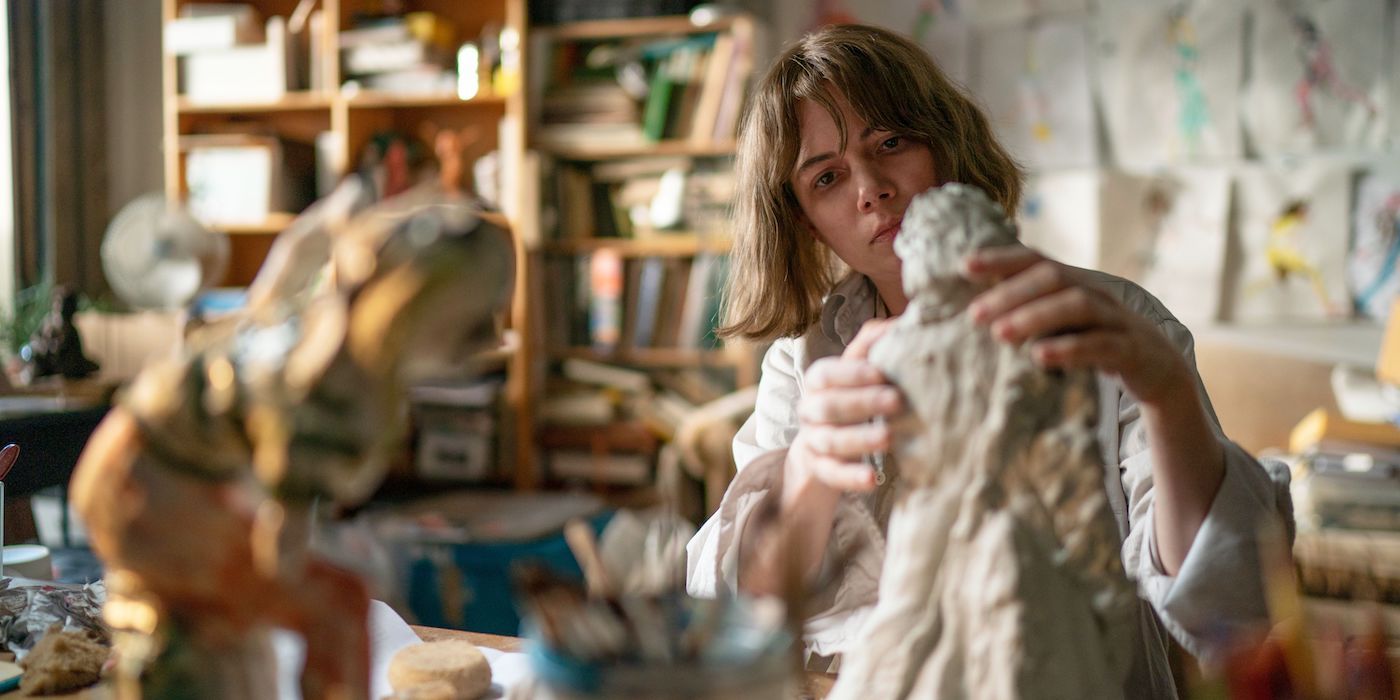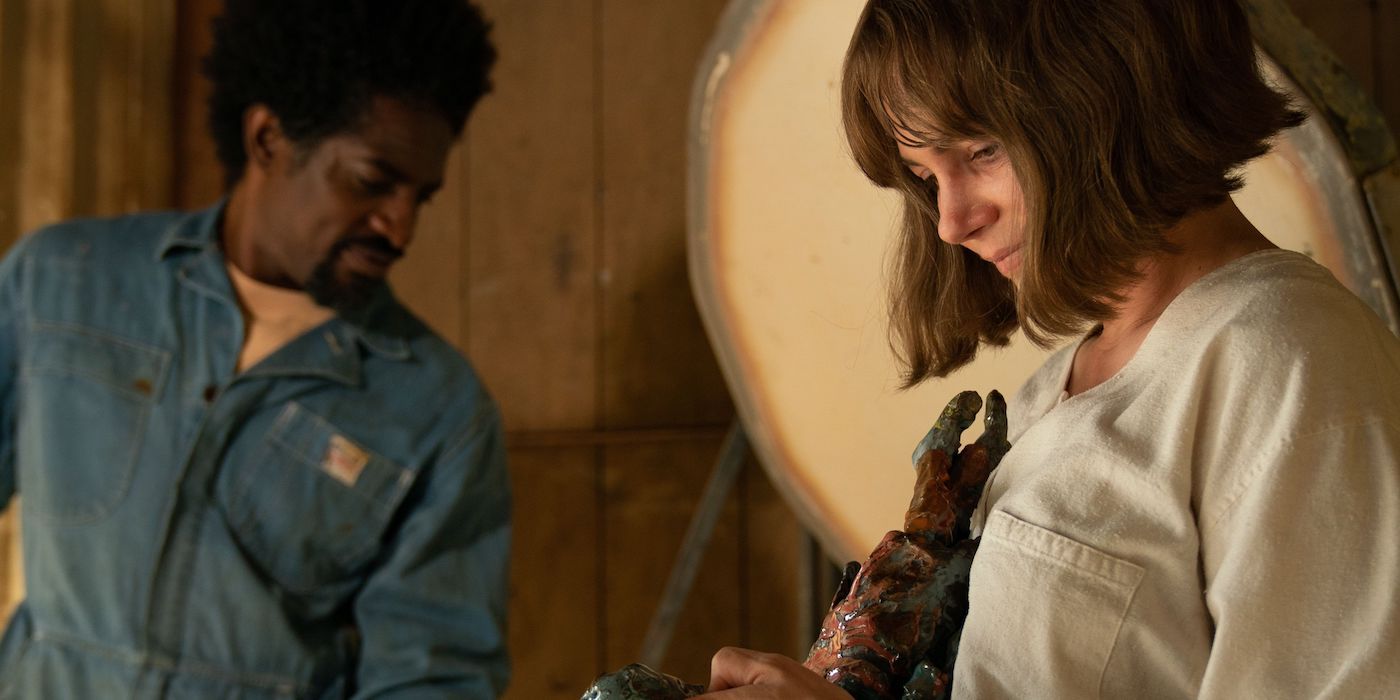What is it to be an artist? The desire to create, no matter what form it takes, can be one of life’s true joys just as it is one of its most crushing. You are able to make something where there once was nothing, shouting into the void of the world with your passion that comes to life via writing, filmmaking, or, as is the case in Kelly Reichardt’s latest film Showing Up, sculpting. Specifically, it is the life of Michelle William’s Lizzy in which all this is contained.
Though it is a film that is minimalist in the way that Reichardt remains most adept as she finds something dynamic in even the smallest of details, there remains a greater sense of mirth crossed with melancholy. To merely call it her funniest film would be a gross oversimplification, as there is a profound sadness woven throughout it while still being subtly silly. In everything from a quick cut to someone who is no longer there to the repeated stepping over of a dog in a doorway, everything comes to life with an understated yet still humorous disposition. It is an existential humor, delicately capturing the experience of being alive and the way there just never seems to be enough time for what it is we love. It is an experience that has the potential to lay you flat the more times that you cycle through it. While not as propulsive as many of Reichardt’s past works, the simplicity of the story is brought to life with an attention to detail that makes for something distinct in her vast cinematic oeuvre.
This all begins and ends with Lizzy. She lives in Portland, Oregon and works in the administrative office of an arts school while preparing to open a new show of her sculptures. She has a cat and a landlord named Jo (Hong Chau) who, in addition to also being an artist, is a point of frustration for Lizzy as she has yet to fix her hot water. An early encounter between the two sees each seeming to talk past the other with Jo more interested in a tire swing than anything else. It results in a concluding punchline to the conversation that is perfectly timed, capturing the frustration that Lizzy has about the whole situation via her sudden absence. Reichardt, who also serves as editor on the film, is just so good at knowing when to cut for the maximum impact that the whole film really sings. Everything just flows together naturally, pulling us deeper and deeper into Lizzy’s little corner of the world. When not defined by her working at her art, it is also about her reckoning with her family who all have their own relationships to her. She works for her mother Jean (Maryann Plunkett) which complicates their interactions. Her father Bill (Judd Hirsch) is a retired artist who is content to be just bumming around. However, it is the relationship Lizzy has with her brother that proves to be the most illuminating even as it remains fleeting just like all our lives themselves are.
Sean, played by John Magaro who Reichardt worked with on her 2019 film First Cow, is the character who is the most troubled. Though both her parents are largely unbothered by their son’s isolation, Lizzy remains increasingly concerned about him. When she visits his home, Sean seems to be growing even more distant from the world around him. He bemoans that he can’t watch television anymore, a slightly humorous complaint that takes on a more worrying edge when he explains that he believes his neighbors are behind it. As Lizzy tries to gently push back on this, he closes off even further and a sliver of resentment creeps into his tone. In a film more interested in explosive confrontations, this could easily devolve into a shouting match. Instead, Reichardt lets things play out with far more patience so it overflows with authenticity. This gives room for Magaro to really capture a character who is growing more and more lost just as someone is trying to extend a helping hand that may be too late.
For anyone who has ever been in such a situation, the pain and discomfort from such a moment can break you without warning. The way Williams, who is largely reserved throughout the entire film, embodies a quiet care for her brother is deeply affecting. You can see all of what she feels in everything from the manner in which she carries herself to the way her face will shift at a statement. The introduction of an animal that she begins to care for, a recurrent motif in Reichardt’s films, shows how she is trying to make things better in the ways that she can to make up for all the ways that she can’t. There is a rich familiarity that is built with this as it shows Lizzy when she is alone. She isn’t lonely per se, often appearing to be most content when just given the chance to create, though there are moments where she seems like she wants someone to reach out to her as she puts herself out there via her art.
There are those that do, but there remains a sense of artistic disconnection that the film wades through. Most interestingly, it is Sean who gives voice to this in one key scene when he says that “you have to listen to what isn’t being said.” This statement, especially on a second watch, proves to be the most illuminating of the film. Just the moments where we get to sit with the simple yet beautifully shot scenes by Reichardt’s longtime cinematographer Christopher Blauvelt carry with them a greater weight. They easily could pass by as being insignificant, but you soon come to see that everything is essential. All the glimpses we get of the students at the school, the art that is being constructed, and the particulars of this small community uncover what it is to be alive. While all film is an abstraction of life, there is something that feels just so naturalistic and enthralling to how Reichardt approaches this story. The plot matters less than the emotional experience, itself a form of creation about what it means to create and the way we try to make sense of the troubles in our lives at the same time. The film is simply about being, cutting through all the noise as Sean said to hear what it is that is really going on. Sometimes, life is just about showing up and being present.
When Lizzy wanders down a hall at the school, she takes a moment to look into a room where someone is working on a project. Most other films would simply skip past this, but Reichardt makes it something that we must pay attention to. Though it passes rather quickly, the film loops back around on it towards the very conclusion. Without giving anything away, there is a closing sequence where we just are left to wander away from what the film has ostensibly been building to with Lizzy’s show. It is as if all of that, when it all comes down to it, is not what matters about life. Instead, it is the act of being and creating itself that is what makes life worth living. The process can be full of pain, but there is nothing quite like getting to just take in the world around you then put something back into it. When Reichardt cuts to the end credits after the concluding shot to let us just take that in, we see again the artist making alone. It was as the film began and, as we now see, is exactly what Sean was talking about. In a world of so much noise, it is Reichardt’s Showing Up that proves to be present and powerful in its accumulation of small moments that come together into something spectacular.
Rating: A
Showing Up is in theaters starting April 7.
#Michelle #Williams #Creates #Sublime #Character #Study



